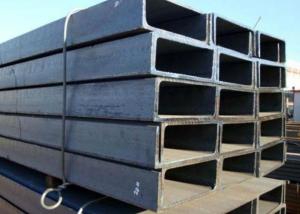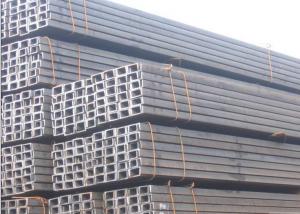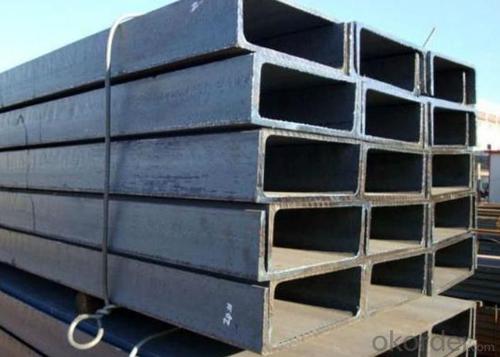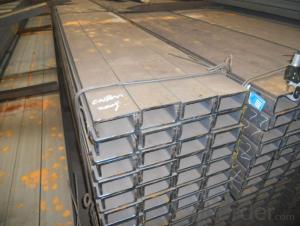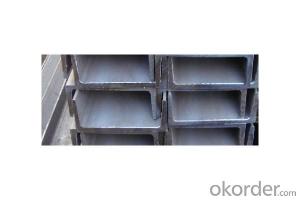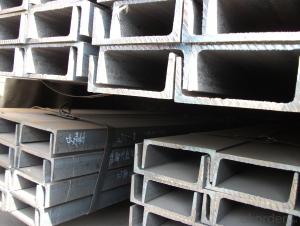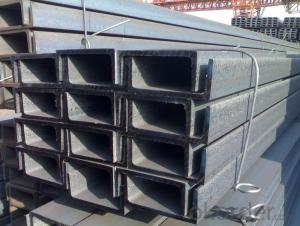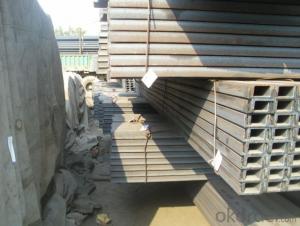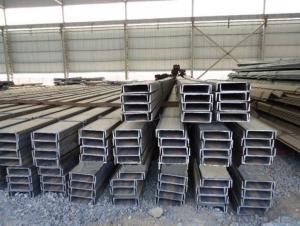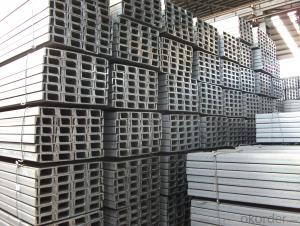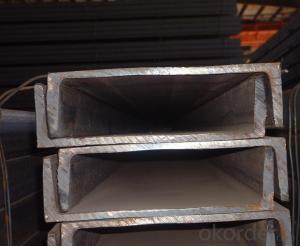Hot Rolled Channel steel
- Loading Port:
- Xingang Port
- Payment Terms:
- TT or LC
- Min Order Qty:
- 25MT m.t.
- Supply Capability:
- 80000-100000MTS/YEAR m.t./month
OKorder Service Pledge
OKorder Financial Service
You Might Also Like
Specifications of Hot Rolled Channel Steel:
1. We are definitely speciallizing in manufacturing and supplying channel steel as per japanese standard, which is characterised with high mechanical strength and competitive prices.
Original Place | Tangshan, China | Brand Name | UINDA |
Standard | JIS G3192 : 1990 | ||
Material Grade | SS540 | ||
Sizes | 50mm to 200mm | ||
Sales Volume/Year | 3000MT | ||
Destination Area | Middle East, Africa, Southeast Asia | ||
2. The sections in details are as followings in the table-1
JIS U CHANNEL | Standard | Sectional | Dimension |
| Mass: |
| (mm) | (mm) | (mm) | (mm) |
|
50x25 | 50 | 25 | 3.0 | 6.00 | 2.37 |
75X40 | 75 | 40 | 3.8 | 7.00 | 5.30 |
75X40 | 75 | 40 | 4.0 | 7.00 | 5.60 |
75X40 | 75 | 40 | 4.5 | 7.00 | 5.85 |
75X40 | 75 | 40 | 5.0 | 7.00 | 6.92 |
|
|
|
|
|
|
100X50 | 100 | 50 | 3.8 | 6.00 | 7.30 |
100X50 | 100 | 50 | 4.2 | 6.00 | 8.03 |
100X50 | 100 | 50 | 4.5 | 7.50 | 8.97 |
100X50 | 100 | 50 | 5.0 | 7.50 | 9.36 |
|
|
|
|
|
|
125X65 | 125 | 65 | 5.2 | 6.80 | 11.66 |
125X65 | 125 | 65 | 5.3 | 6.80 | 12.17 |
125X65 | 125 | 65 | 5.5 | 8.00 | 12.91 |
125X65 | 125 | 65 | 6.0 | 8.00 | 13.40 |
|
|
|
|
|
|
150x75 | 150 | 75 | 5.5 | 7.30 | 14.66 |
150x75 | 150 | 75 | 5.7 | 10.00 | 16.71 |
150x75 | 150 | 75 | 6.0 | 10.00 | 17.90 |
150x75 | 150 | 75 | 6.5 | 10.00 | 18.60 |
150x75 | 150 | 75 | 6.5 | 10.00 | 24.00 |
|
|
|
|
|
|
200X80 | 200 | 80 | 7.5 | 11.00 | 24.60 |
Table-1
3. The mechanical property of Hot Rolled Channel Steel in the table-2:
Grade | Yield Strength,N/mm² | Extension Strength N/mm² | |||
Thickness of Steel,mm | |||||
≦16 | >16-≦40 | >40-≦100 | >100 | ||
SS540 | ≧400 | ≧390 | - | - | ≧540 |
Table-2
4. The chemical composition of Hot Rolled Channel Steel as per SS540 in the table-3
Grade | Yield Strength,N/mm² | Extension Strength N/mm² | |||
Thickness of Steel,mm | |||||
≦16 | >16-≦40 | >40-≦100 | >100 | ||
SS540 | ≧400 | ≧390 | - | - | ≧540 |
Table-3
Usage of Hot Rolled Channel Steel:
1.The Hot Rolled Channel Steel can be devided into two kinds, namely common channel steel and light channel steel. The sizes of hot rolled common channel steel range from 5# to 40#. Meanwhile, the channel steel can be divided into cold forming sectional equal channel steel, cold forming sectional unequal channel steel, cold forming inner edge channel steel and outer edge channel steel.
2.The hot rolled channel steel is usually used for arch-itechtural structure, and they could be welded in order to support or hang a vari-ety of facilities. They are also usually used in combination with I beam. The channel steel with sizes under 14# is usually applied to construction engineering, as purline, while the channel steel with sizes above 16# is more likely to be used in building vehicle chassis structure and mechanical structure. Furthermore, the channel steel in sizes above 30# are target at building bridge structure, as tension bar.
3.In a word, the channel steel must possess perfect welding property, riveting property and mechanical property and so on.
Package & Delivery of Hot Rolled Channel Steel:
1.The hot rolled channel steel will be packed in bundle with steel wire at each end of every bundle and color marking in order to help the customer to recognize his goods more easily at sight.
2. And the channel steel could be loaded into 20ft or 40ft container, or by bulk cargo.If the weight of each bundle reaches more than 3.5 mt, the loading by break bulk cargo should be choosed.When the weight of each bundle reaches less than 3mt, the loading by container should be choosed.
3.As for the transportaion from mill to loading port, the truck will be usually used. And the maximum quantity for each truck is 40mt.
4.All in all, we could do in accordance with customer's request.
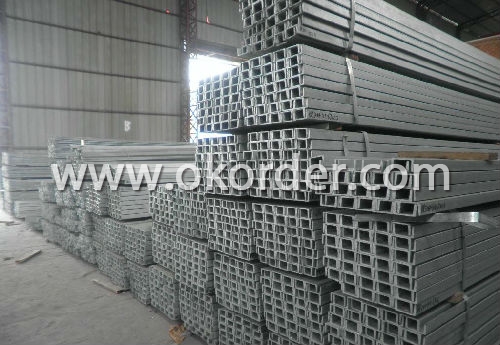
Production Flow of Hot Rolled Channel Steel:
1.The steel billet shall be heated in the high temperature furnace.
2. The heated steel billet shall be rolled five to nine times with the aim of shaping the general figure of steel u channel.
3. The rolled steel u channel should be put onto the cooling bed to make the temperature low.
4. The steel u channel should be straighted on the straightener.
5. The straighted steel u channel will be cut into meters by saw, as per customer's requirements.
6. At the last part of production, the channel steel must be tested in order to confirm that the finished products are completely free from crack, pore, slag, scab or fold on the surface.
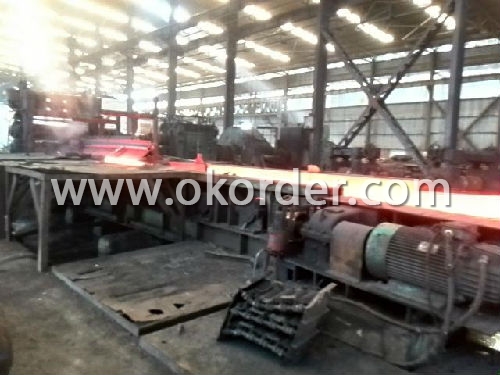
- Q: Can steel channels be used for solar panel mounting?
- Indeed, steel channels have the ability to be utilized for the purpose of mounting solar panels. Opting for steel channels as a mounting solution not only offers robustness and longevity, but also the capacity to bear the weight of the panels and withstand diverse weather conditions. Moreover, steel channels can be effortlessly tailored and adapted to meet the precise demands of the solar panel installation. They furnish a dependable base for the panels, allowing for installation on rooftops, ground mounts, or other structures. Nevertheless, it is crucial to guarantee the proper installation and anchoring of the steel channels to ensure the requisite stability for the solar panels.
- Q: How do steel channels contribute to the overall aesthetics of a building?
- Steel channels can contribute to the overall aesthetics of a building in a number of ways. Firstly, their sleek and streamlined design adds a modern and contemporary touch to the structure. The clean lines and sharp edges of steel channels create a visually appealing look, enhancing the overall aesthetic appeal of the building. Additionally, steel channels offer versatility in terms of design possibilities. They can be used to create unique and intricate patterns, adding visual interest to the building's facade. Whether used horizontally, vertically, or diagonally, steel channels allow for creative expression, enabling architects and designers to create stunning and eye-catching architectural features. Furthermore, steel channels can be finished in a variety of ways to complement the overall design concept of the building. They can be painted in different colors, providing a bold or subtle contrast to the surrounding materials. Alternatively, steel channels can be left exposed, showcasing their natural metallic finish, which can add a touch of industrial elegance to the building's aesthetic. Moreover, steel channels are highly durable and long-lasting, which is not only beneficial from a structural standpoint but also contributes to the overall aesthetics. The longevity of steel channels ensures that the building maintains its aesthetic appeal for years to come, without the need for frequent repairs or replacements. In summary, steel channels contribute to the overall aesthetics of a building by adding a sleek and modern touch, offering design versatility, allowing for various finishes, and providing durability. Their ability to enhance the visual appeal of a structure makes them a popular choice among architects and designers looking to create aesthetically pleasing buildings.
- Q: Can steel channels be used in the agricultural manufacturing industry?
- Yes, steel channels can be used in the agricultural manufacturing industry. Steel channels are versatile and durable, making them suitable for various applications in agriculture, such as constructing farm equipment, machinery, and structures like barns and sheds.
- Q: Can steel channels be used for creating support structures for communication towers?
- Indeed, support structures for communication towers can be constructed using steel channels. Owing to their robustness and enduring nature, steel channels are frequently employed in the realm of construction. They offer exceptional reinforcement for substantial burdens and can endure diverse environmental circumstances, rendering them fitting for integration in communication tower structures. The fabrication, cutting, and welding of steel channels to fulfill the precise demands of the tower design can be accomplished with ease. Furthermore, their symmetrical form and unwavering measurements render them optimal for establishing steadfast and dependable support structures.
- Q: What are the different types of clamps used for steel channels?
- There are several different types of clamps used for steel channels, including beam clamps, channel clamps, strut clamps, pipe clamps, and C-clamps. Each type of clamp is designed to securely hold steel channels in place and provide support for various applications.
- Q: What is the cost of steel channels compared to other materials?
- The price of steel channels can vary based on several factors, including the type and grade of steel, market demand, and location. Generally, steel channels are more expensive than materials like wood or aluminum, but they can be more cost-effective than stainless steel or titanium. Steel channels have numerous advantages that justify their higher cost. They are known for their strength, durability, and corrosion resistance, making them suitable for various applications in construction, manufacturing, and infrastructure projects. Steel channels also have excellent load-bearing capabilities, allowing them to support heavy loads and withstand extreme conditions. Furthermore, steel channels are readily available in standard sizes and can be easily obtained from local suppliers or manufacturers. This accessibility contributes to lower transportation costs compared to materials that may need to be imported. It is important to note that the cost of steel channels can also be influenced by market fluctuations, such as changes in raw material prices or tariffs. Therefore, conducting thorough research and obtaining quotes from different suppliers is essential to accurately understand the current cost of steel channels in relation to other materials.
- Q: Is the channel 20 the same as the channel 20b?
- No, channel 20, a and B two.20A specifications are: 200*73*7.0, weight per meter is 22.637kg20b specifications are: 200*75*9.0, weight per meter is 25.777kg
- Q: How many pieces of channel steel?
- Channel steel is mainly used in building structure, curtain wall engineering, mechanical equipment and vehicle manufacturing, etc.. In use, it requires better welding, riveting performance and comprehensive mechanical properties.
- Q: What are the different testing methods for steel channels?
- There are several testing methods available for steel channels to ensure their quality and performance. These methods include dimensional inspection, visual inspection, magnetic particle testing, ultrasonic testing, and load testing. 1. Dimensional Inspection: This method involves measuring the dimensions of the steel channels to ensure they meet the required specifications. It checks for deviations in length, width, height, and thickness. 2. Visual Inspection: Visual inspection is conducted to detect any visible defects such as surface cracks, corrosion, dents, or other imperfections that can affect the structural integrity or aesthetics of the steel channels. 3. Magnetic Particle Testing: This non-destructive testing method uses magnetic fields and magnetic particles to identify surface and near-surface defects in the steel channels. It is particularly effective in detecting cracks, weld defects, and other discontinuities. 4. Ultrasonic Testing: Ultrasonic testing utilizes high-frequency sound waves to detect internal flaws or defects in the steel channels. It can identify cracks, voids, and other irregularities that may not be visible to the naked eye. 5. Load Testing: Load testing involves subjecting the steel channels to a specified load or force to evaluate their strength and structural integrity. This method helps determine if the channels can withstand the expected loads and stresses they will encounter in their intended applications. These testing methods provide crucial information about the quality and suitability of steel channels for various construction and engineering purposes. By conducting these tests, manufacturers and users can ensure the safety, reliability, and performance of steel channels in their respective applications.
- Q: How are steel channels used in structural applications?
- Steel channels are widely used in structural applications due to their excellent strength and versatility. They are commonly used in the construction industry for supporting heavy loads and providing structural integrity to buildings, bridges, and other infrastructures. One of the main applications of steel channels is in the framing of buildings. They are often used as beams or columns to support the weight of floors, walls, and roofs. Steel channels are chosen for these applications because they can withstand a significant amount of load without deforming or collapsing. In addition to building frames, steel channels are also used for bracing and reinforcing structures. They can be used as diagonal braces to provide lateral stability and prevent the structure from swaying or collapsing under wind or seismic forces. Steel channels are also utilized as reinforcement in concrete structures, such as retaining walls and foundations, to enhance their strength and durability. Steel channels are also employed in the manufacturing of machinery and equipment. They provide a stable and rigid framework for heavy machinery, allowing them to operate smoothly and efficiently. In this context, steel channels are often used as support beams, frames, or structural components in various industrial applications. Furthermore, steel channels find application in the transportation industry. They are used in the construction of bridges and overpasses, where their high strength and load-bearing capacity are essential for safely carrying vehicles and pedestrians. Steel channels are also utilized in the manufacturing of railway tracks and tramways, providing a durable and stable foundation for the transportation system. Overall, steel channels play a crucial role in structural applications by providing strength, stability, and durability to various types of constructions. Their versatility and ability to withstand heavy loads make them a preferred choice in the construction, manufacturing, and transportation industries.
1. Manufacturer Overview
| Location | Tangshan, China |
| Year Established | 2000 |
| Annual Output Value | Above US$ 50 Million |
| Main Markets | Mid East; Southeast Asia; Korea |
| Company Certifications |
2. Manufacturer Certificates
| a) Certification Name | |
| Range | |
| Reference | |
| Validity Period |
3. Manufacturer Capability
| a) Trade Capacity | |
| Nearest Port | Tianjin |
| Export Percentage | 20% - 30% |
| No.of Employees in Trade Department | 10-20 People |
| Language Spoken: | English; Chinese |
| b) Factory Information | |
| Factory Size: | Above 81,000 square meters |
| No. of Production Lines | 1 |
| Contract Manufacturing | OEM Service Offered |
| Product Price Range | Average |
Send your message to us
Hot Rolled Channel steel
- Loading Port:
- Xingang Port
- Payment Terms:
- TT or LC
- Min Order Qty:
- 25MT m.t.
- Supply Capability:
- 80000-100000MTS/YEAR m.t./month
OKorder Service Pledge
OKorder Financial Service
Similar products
Hot products
Hot Searches
Related keywords
